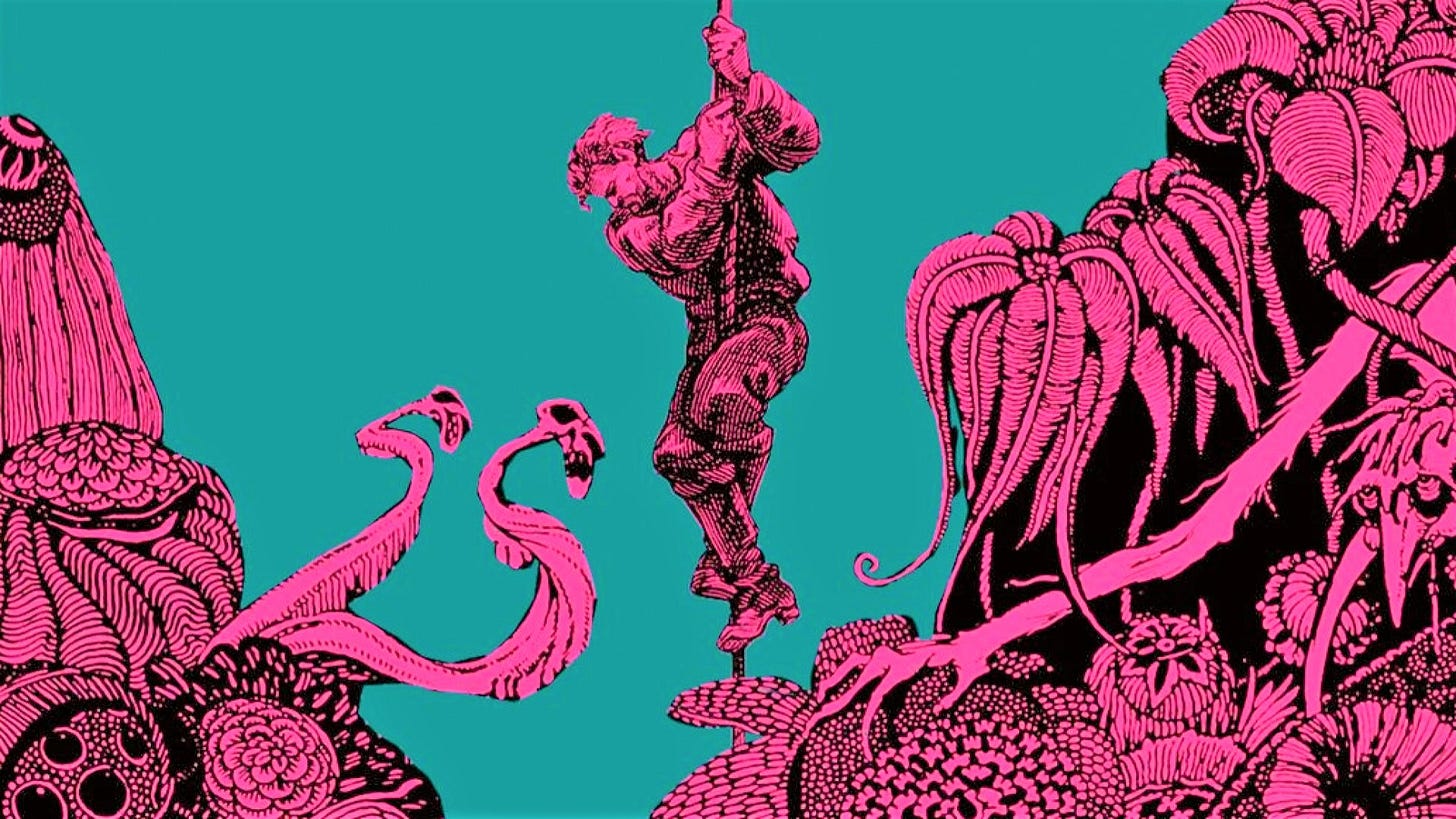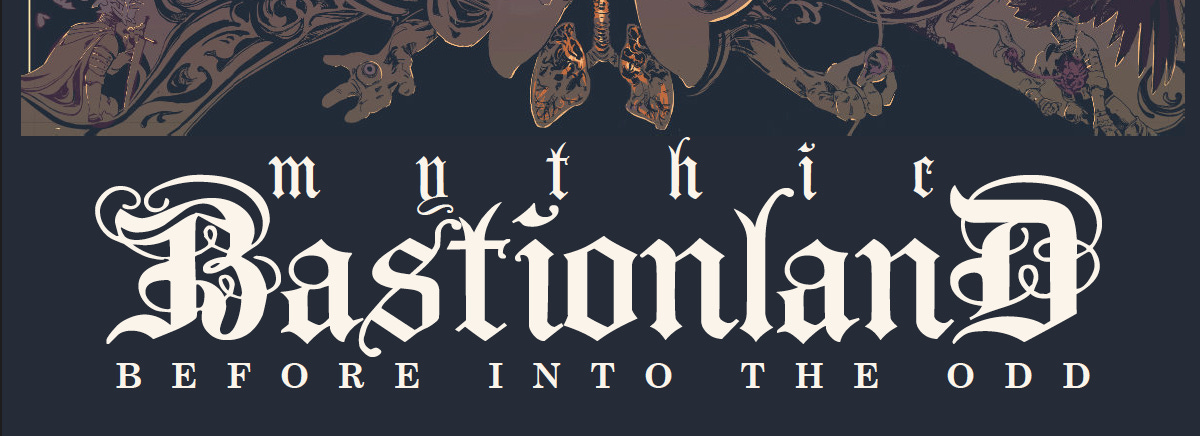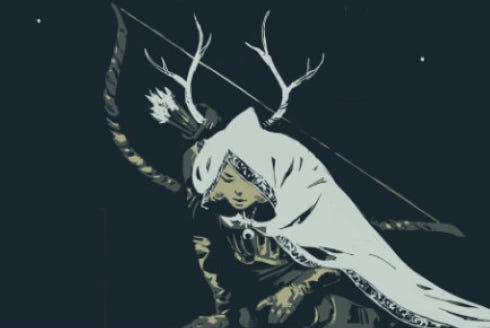Cracking the Code of Mythic Bastionland: A One-on-One with RPG Maestro Chris McDowall
We journey beyond Into the Odd and Electric Bastionland to unearth the legends and myths that fuel this elegant knight RPG
In this interview I talk with Chris McDowall, the creator of Into the Odd and Electric Bastionland, among other recent indie RPG classics. His latest game is Mythic Bastionland, where you play as a knight rising in power in a dreamlike medieval European world.
NOTE: Mythic Bastionland is live on Kickstarter.
Hiya Chris! Can you introduce yourself and tell us what you’ve done in the world of RPGs?
Hi! I'm Chris McDowall, and I've designed the RPGs Into the Odd and Electric Bastionland as well as the wargame The Doomed. My focus is on trying to create games that have light rules, fast gameplay, and lots of flavour to get the table inspired.
I also blog at bastionland.com, which will be celebrating 15 years in January, making me feel very old!
At the moment I'm neck-deep in finishing up Mythic Bastionland, my game of knights, myths, and exploring a strange wilderness.

I want to get into Mythic Bastionland in a minute. But Into the Odd and Electric Bastionland are your two biggest hits thus far. They’re both games set in wildly imaginative worlds. Where did all that crazy imagery come from?
My settings grow out of two main sources, from real-world things that resonate with me and from the needs of the game itself. In short, the key elements of that setting come from wanting a world that's easy to run a game in, while still feeling like a real place.
Bastion being "the only city that matters" came from my original setting having a handful of cities. They each felt sort of one-dimensional, so I smashed them together into one more interesting city. Then I drew a lot of little details from how visiting a city would feel as somebody who grew up in a small town.
Deep Country is the rural world outside of Bastion, and there's a mention that "traveling out there is like traveling back through time," That came about so that you can plug in ideas from just about any period of history and have it fit in the world. I draw a lot of Deep Country ideas from how the rural area that I grew up in can feel strange to go back to now that I live in a large city.
The Underground that spreads below the world is also slightly below space and time, so if you've got a dungeon you want to use in your game you don't have to worry about where it makes sense to put it. When I visited London as a kid I was fascinated by its Underground as this world below ours, where you could vanish below and emerge somewhere completely different, and I guess this is just taking that to an extreme.
So yeah, some of these setting elements can be quite wild, but I try to add in enough real-world inspiration that they still feel grounded within the reality of the setting.
Into the Odd was picked up by Free League and “remastered” with artwork from Johan Nohr (of Mork Borg and CY_BORG fame). This new version is, in fact, a beautiful artifact and a testament to why we’re in the golden age of RPGs right now. What’s the story behind how your game got picked up by Free League?
Back when they were preparing their Kickstarter for Forbidden Lands, Nils from Free League got in touch and asked if I wanted to design a dungeon for one of their stretch goals. When we got chatting he mentioned that he and some of the other Free League guys really liked Into the Odd, which to be honest I assumed was just him being polite!
Then, after I released Electric Bastionland, I was surprised at how many people were still asking about Into the Odd and what I had planned for it. They seemed to like the game as it was, so I didn't want to create a new edition with different rules, but I loved the idea of creating a definitive version of the game. The same rules as the original, but all new art, a new layout, and some extra content to play with. Nils and I had kept in touch, and when I ran this idea past him he said it sounded like a great fit for Free League's workshop label, where they deal with printing and distribution, but leave the design entirely to the creator.
I knew that I wanted a single person to create all of the art for the game, and I'd already chatted with Johan on my podcast. He'd just released Mork Borg, and while I didn't want that look for Into the Odd, I thought he'd be the perfect person to give it a unique visual identity.
While I do publish some of my own games, for this particular one it was ideal to work with a team with all that expertise in printing, marketing, and distribution, while still having total control over what the actual book was going to be. I'm hugely proud of how it came out.
I had the privilege of meeting you in person at GenCon in Indianapolis this year and we briefly discussed your upcoming game Mythic Bastionland. We only got to talk about it for a short time. So let’s get into it a bit here. First, can you describe in general terms what Mythic Bastionland is and what its relation to Electric Bastionland is?
Mythic Bastionland is a game about Knights exploring a strange wilderness and seeking out Myths under the guidance of sinister Seers. With enough Glory you might find a place in court or take rule of your own holding, all while the passage of time pushes you to consider a successor to your legacy.
Into the Odd was my take on dungeon crawling play and Electric Bastionland was more about the city, so Mythic Bastionland is very much focused on the wilderness, seeing you hex-crawl around the mythic past of this world.
In terms of connections to Electric Bastionland, it uses the same system with some new additions, and there are certainly hints that you can tie both games into the same setting if you know the right way to go.
In your inspirations section you mention a number of great and legendary RPGs. The first game that comes to my mind when someone says “knight RPG” is Pendragon, which is one of the games you’ve listed by Greg Stafford. What elements from Pendragon did you borrow or were inspired by when forging Mythic Bastionland?
Often my RPGs are inspired by the idea of a particular RPG, more so than its actual contents. So Into the Odd was very much inspired by how I imagined D&D would play before I ever got a chance to try it out or read through the rules, leaning into the horrific monsters and bizarre magic items.
I've only played Pendragon a few times, and only as one-shots, but I always loved the idea of the Great Pendragon Campaign, where you play through one year per session, your Knights growing older and eventually dying, passing the mantle on to their heir. I wanted to tap into that even for shorter campaigns of a handful of sessions. So here you've got the Into the Odd style take on that, where you can do things like earn glory, take a seat in court, run a domain, fight in wars, grow old, and die, but with a very rules light, fast running approach to it all.
Can you describe the play cycle of a one-shot in Mythic Bastionland?
At the start of the book there are guidelines for how to set up the game for short campaigns, long campaigns, and one-shots, and whether you want the Knights to be just starting out or already established and in positions of power.
For new Knights in a one-shot it would start with the Knights arriving in the Realm and encountering an Omen of the nearest Myth. Each Realm has six Myths scattered around the Hex Map, each gradually revealing itself through six Omens that occur in order. They're basically short encounters that might involve a supernatural creature, or be a more mundane event linked to their presence. Things tend to escalate until the sixth Omen is something pretty major like an attack on a nearby Holding or being whisked away to another world.
Between these Omens the Knights will be traveling through the Realm, dealing with the rulers of each holding, and finding local landmarks that can help or hinder their journey. They also have to deal with Seers, who know the past, present, and future in various ways, but have their own agendas that limit how much they're willing or able to help the Knights.
This is all designed to run very quickly and rulte-lite, so even in a one shot I've found you can fit in a handful of weird omen encounters, a bit of combat, plenty of traveling, and some social maneuvering.
What does a more long-form campaign in Mythic Bastionland look like? Do players end up managing domains or anything like that?
I wanted a campaign system that felt like you were rising from petty Knights right up to being rulers, but I didn't want it to be tied into how overtly powerful your Knight was, or any real concept of level like you might see in D&D. Pendragon has its own Glory system, and the Prince Valiant Storytelling Game has a Fame system, but they weren't quite what I was looking for.
Knights gain Glory by uncovering Myths, besting other Knights in duels, or fighting in significant battles. Glory doesn't make a Knight more powerful, but it gradually opens up worthiness for positions like leading an army, sitting in court, or ruling a holding, also granting your Knights a new title to show their achievements.
Crises will strike your domain, courtly drama will need managing, you can muster armies and gather taxes, but I wanted it all to feed back into the actual actions of your Knight, rather than becoming a management minigame you do between adventures. Really, these systems are just there to create new types of challenges for the players, while offering new tools for them to use like armies and treasuries.
That image of King Conan, bored on the throne, is iconic, but it's not how I want my RPG campaigns to end up!
What are “Myths” in Mythic Bastionland and how do they work?
In the world of Mythic Bastionland there's no such thing as "just a myth", so every story and legend is really just a truth waiting to emerge.
The book has 72 of these Myths, such as the Wyvern, the Goblin, the Forest, and the Eye, and you'll place six in your Realm when preparing the game. Each Myth is made up of six omens that will be encountered in order, but you never quite know which Myth's omen is going to be encountered next. This means the Knights have to piece together the encounters to get a sense of what exactly is threatening them and how to deal with it in a way that protects the Realm.
So many fantasy RPGs old and new can be connected right back to Medieval England, and clearly Mythic Bastionland centers on that same vibe. But nowhere in the 72-page playtest PDF of the game do you overtly suggest either England or the Middle Ages. How easy would it be for me to reskin this game to take place in, say medieval Japan or a medieval space knight setting of my own invention? And I guess on that note, do you have any plans to release a 3rd party license with this game?
I definitely wanted to tap into elements of British medieval history and mythology, but I wanted to avoid tying it too closely to anything specifically of our world. After all, this is meant to be the mythological history of Bastionland, so having something where the reader might think "oh that's meant to be Avalon and that's meant to be the Green Knight '' wouldn't feel right.
I've tried to evoke the same feelings I get from that inspirational material, while leaving things open enough that you could absolutely create your own Knights and Omens that would fit a setting inspired by different sources.
I plan on working parts of Mythic Bastionland into the Mark of the Odd license, likely after the final release. I'm excited to see what people decide to do with this system as a foundation.
The artwork by Alec Sorensen for this book is spellbinding and very evocative. How did you find Alec and what was the process like with Alec in getting to this aesthetic?
Alec also did the artwork for Electric Bastionland, so I knew from the start that I wanted to work with him again for this book. I wanted it to feel like something that could almost be actually medieval, so we spoke a lot about tapestry and stained glass windows. I also wanted everything to feel a bit abstract and dreamy, like it's not quite real. Again, this feeds into the idea that this is a place of myth, not history.
I love how the artwork is coming along so far, especially how many little details are tucked away in the background and embellishments of each piece. Really helps it feel like the world is full of mysteries for you to discover.
What are a few of your favorite movies or books about knights?
The recent Green Knight film actually came out at a very fortunate time, right as I was in the middle of writing Mythic Bastionland. It definitely captures a lot of the dreamlike tone that I was aiming for.
My real guilty pleasure is the 1981 film Excalibur. You get Arthur's origin, rise, decline, revival, and death, all crammed into one film. You get Merlin feeling like he belongs in a completely different film. You get some truly ludicrous sets and costumes. It's glorious, and carries a lot of the chaos that you'd normally get from an RPG campaign.
Another big source of inspiration were Hal Foster's Prince Valiant comic strips. Each panel is just packed with details that make the world feel real, without being cluttered, and the action is kinetic and brutal, at least as much as a newspaper comic strip allows. It's like the perfect balance of how I try to run RPG sessions.
I put out a video that acted as a collection of GM advice from three different RPGs, one of them Electric Bastionland. The advice from your book is staggeringly concise and almost at a brutal right angle against normal, traditional approaches to GMing. How did you derive this wisdom and what inspired you to deliver it in such brief terms?
The advice in my books very rarely comes from some unique insight that I've had. I still have a lot to learn about how to run games, so when I do run a game I usually note down a few short tips to remember, keeping them in front of me when we play. Often they just act as a little reminder of something I've read elsewhere. For my books I try to find a middle ground where those longer pieces of advice can be condensed down to something very short, like three bullet points.
I've joked before that most of these tips come from me being a very impatient person, and I think there's some truth to that! I find it much easier to digest short-form advice, and systems that run on simple principles rather than intricate rule systems, and I'm glad that other people have also found that style useful.
With OSR-style play, a lot of the great advice is scattered around on various blogs, so I'd always encourage people to check them out. There are a few good lists out there that highlight the really significant posts, so that's a great place to start.
You have a great blog, bastionland.com, that also has some important links to all your other media and social platforms: Patreon, Discord, Twitter, YouTube, Twitch and a podcast. How do you feel about creating content and engaging across that many platforms?
I think long form stuff like the blog and newsletter will always be my main outlet. I've been doing it for nearly 15 years now, and I still think it's the most interesting platform for exploring new ideas.
My videos really started as something to do during the first COVID lockdown, and while I do enjoy them I've got no ambition to dive headlong into the trials and tribulations that YouTubers have to go through. You have my admiration and my sympathy in that regard!
The podcast is the medium that I'd love to explore more, as it's mainly an excuse to chat with people who I admire. It can be time consuming but I'm definitely planning another series to come next year.














I Kickstarted this one after seeing Kyle Latino's video on the sites/hexcrawl mechanics and it's one of the best investments I ever made. Just the Sites rules alone were worth the price; it's probably the most powerful RPG tool I've ever encountered and works for everything from dungeons to city blocks to character webs to investigation challenges and even out to continent layouts and cosmologies. Never before have I built *so much stuff* for a campaign setting before, or had so much fun doing it, or been so confident in the quality of what I was creating. This little page changed everything for me. I hope more people find their way to this game and to this article. Chris is amazing.